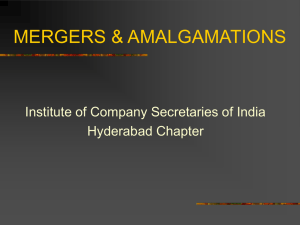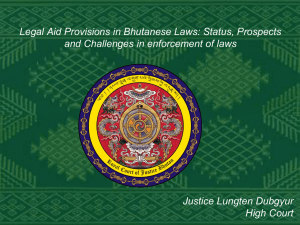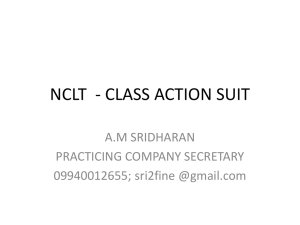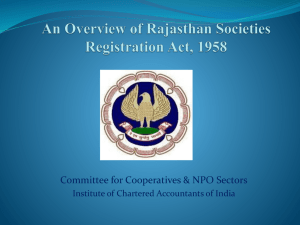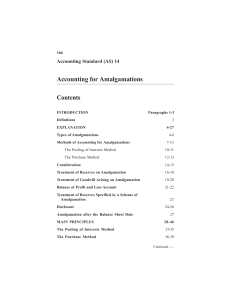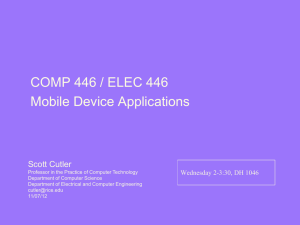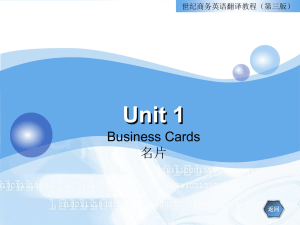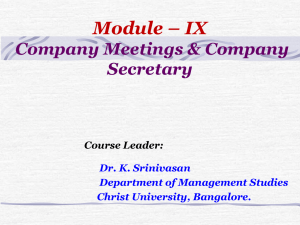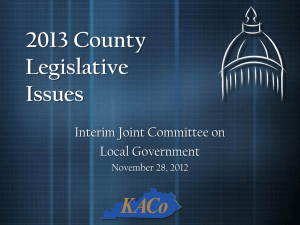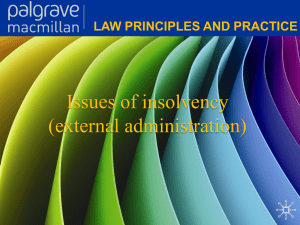Manoj - Presentation - Study Circle Meeting
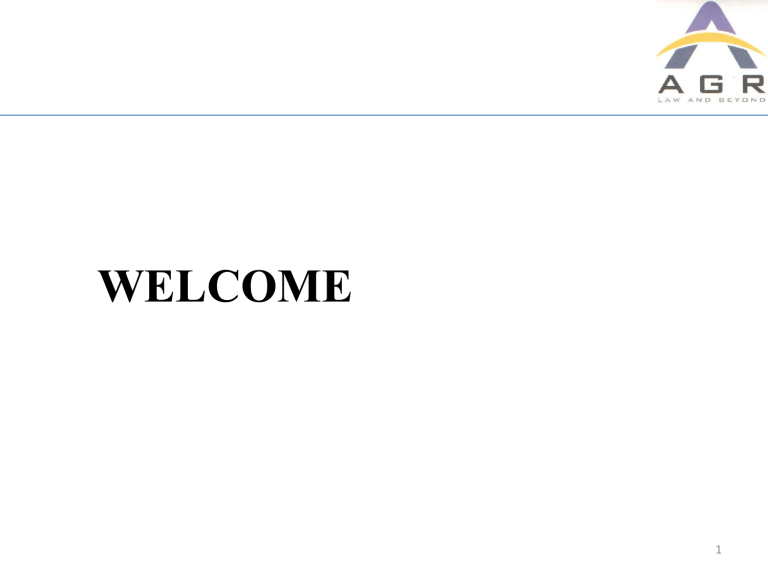
WELCOME
1
Scheme of Arrangement under the
Companies Act, 1956 –
Revised requirements for the Stock
Exchanges and Listed Companies
2
Existing Regulatory Framework
•
Companies Act, 1956 – [Sec 391-394]
•
Listing Agreement
•
FEMA
•
Accounting Standards – 14
•
AP Stamp Act
•
Competition Act, 2002
•
Income Tax Act, 1961
•
Company Court Rules - 67 to 87
3
Companies Act, 1956 – [Sec 391-394]
Section 391 is a COMPLETE CODE BY ITSELF
The scope of this section 391 is very wide.
A comprehensive section, which includes
Merger
Demerger
Reverse Merger
Hiving off of a unit by a company.
Compromise with Creditors
Restructuring, including Re-organisation of the share capital of a company by way of consolidation or division of the shares ( into different classes ) and both;
Composite Scheme, which may include
(i) Change of Name
(ii) Change in Objects Clause
(iii) Reduction of Capital
(iv) Sale, lease etc., of the Company’s Property u/s 293
(v) Change in Management, Promoters and Preferential Allotment (exempted from SEBI (Issue of
Capital and Disclosure Requirements) Regulations
(vi) Others
4
Companies Act, 1956 – [Sec 391-394]
When the scheme envisages various incidental proposals as an integral part of the scheme, the procedures prescribed under the Companies Act, need not be separately undertaken.
Section 391, can act as a Sanjeevini Booti , i.e. One that infuses life, for a
Company, which is under winding up process.
Section 391 can be applied to a company in winding up also.
An arrangement under this section can, therefore, also take a company out of a winding up.
Even though a winding up order has been made, every member has a right to file an application u/s 391 for the revival of the company.
The term AMALGAMATION AND MERGER have not been defined in the
Companies Act 1956, though this voluminous piece of legislation contains 69 definitions in Section 2. However, the provisions relating to M & A are contained in section 391 to 396A in Chapter V of the Companies Act, 1956.
Compromise: There can be no compromise, unless there is some dispute
(Sneath v. Valley Gold Ltd.,)
5
Companies Act, 1956 – [Sec 391-394]
•
The words used under the section are:
–
Compromise & Arrangement between a company and its creditors or any class of them ; or
–
Compromise & Arrangement between a company and its members or any class of them ;
•
Application u/s 391 to the Court (Tribunal), can be moved by:
–
Company
–
Any Creditor
–
Member
–
In the case of a company which is being wound up, the liquidator.
•
Class
In order to constitute a class, members belonging to the class must form a homogenous group with commonality of interest.
Commonality of interests constitutes a class.
Ex: Deposit holders, Debenture holders, Foreign creditors, preferential creditors, secured creditors and unsecured creditors
6
Principles laid down by the Supreme Court in (i) Miheer H.
Mafatlal v. Mafatlal Industries Ltd., and (ii) Hindustan
Lever Employees’ Union v. Hindustan Lever Ltd
That the provisions of the statute have been complied with.
• That the class was fairly represented by those who attended the meeting and that the statutory majority are acting bona fide
• That the arrangement is such as a ‘man of business’ would reasonably approve
•
There should not be any lack of good faith on the part of the majority
•
Scheme not contrary to public interest or any other
• Prudential Business Management Test
7
Companies Act, 1956 – [Sec 391-394]
Procedural Aspects in Mergers and Amalgamations
(i) The Memorandum of Association of both the Transferor and Transferee
Company must provide the power to amalgamate in its objects clause.
To amalgamate is power or object?
It is held that to amalgamate is an inherent power and an express provision in the MOA is not required:
Even Companies with different objects can opt for amalgamation.
8
Companies Act, 1956 – [Sec 391-394]
(ii) Convene the Board Meeting for Transferor and Transferee Companies for approval of Scheme.
(iii) Valuation of shares and fairness of exchange ratio:
–
Once the exchange ratio has been worked out by a recognized firm of chartered accountants who are experts in the field of valuation and if no mistake can be pointed out in the said valuation, it is not for the court to substitute its exchange ratio, especially when the same has been accepted without demur by the overwhelming majority of the shareholders of the two companies.
–
The above principles were uniformly followed by Court while sanctioning a scheme
–
A combination of the yield method, asset value method and market value method was used
–
Courts not to generally question valuation done by independent professional expert and approved by the shareholders
–
Valuation of experts not to be set aside in the absence of fraud or malafides on the part of experts
9
Companies Act, 1956 – [Sec 391-394]
(iv) Filing of Petition with High Court
- If Registered office of both the Companies are situated in jurisdiction of different High Court, then separate petition are required to be filed by the concerned company in their respective High Court, otherwise a single petition can be filed by both the Companies jointly.
- Joint petition
Madras High Court has allowed a joint petition, on the grounds that neither the Companies Act nor the Company Court Rules prohibit filing of
Joint Petition where subject matter is same and common question of law would arise for decision.
10
Companies Act, 1956 – [Sec 391-394]
Meeting as ordered by Court
On receiving a petition, the court may order a meeting of the creditors or class of creditors, or of the members of class of members, to be called, held and conducted such manner as the court directs.
- Whether holding of meeting necessary in all cases?
In case of amalgamation of the wholly owned subsidiary companies with their holding company, the court dispensed with the requirement of calling meetings
Where the concerned shareholders gave their written consent to the proposed scheme, their meeting was dispensed with.
- Where proxies are allowed – may mean, “where proxies are allowed under the articles or other provisions of the Act”. The Court would have no power to allow voting by proxy where it is not allowed by the articles or the other provisions of the Act. For instance creditors or a class meeting, who are not members, no proxy is allowed.
11
Companies Act, 1956 – [Sec 391-394]
(v) Upon hearing of the Petition, the Hon’ble High Court will pass the necessary order
• for convening of the meeting of the Shareholders and Creditors of the respective Companies;
• quorum of the meeting;
• length of the notice of the meeting and mode of service UPC/ Regd Post etc;
•
Newspaper in which the notice of meeting will be published;
•
Court will also appoint the Chairman and an alternate chairman of the respective meetings and fix the honorarium.
12
Companies Act, 1956 – [Sec 391-394]
(vi) The Notice of the respective meetings shall be dispatched to each
Shareholder and Creditors in such mode as directed by the Hon’ble High
Court. The Notice should be dispatched in accordance with the Court order.
The following documents should be enclosed with the Notice:a.) Explanatory Statement b.) A copy of the proposed Scheme of Amalgamation c) Proxy Form & Attendance Slip d) Others, if any
(vii) Publish the Notices of the respective meetings in such newspapers as directed by the Hon’ble High Court before the date of the respective meeting.
13
Companies Act, 1956 – [Sec 391-394]
Not less than 7 days before the date of the meetings the respective
Chairperson of the meeting shall file an affidavit with the Hon’ble High
Court showing that the directions regarding the issue of the notices and publication of notices have been complied with.
(viii) On respective dates convene and hold the meetings of the Shareholders and the Creditors under the chairmanship of the Chairperson appointed by the Hon’ble High Court.
(ix) Approvals and sanctions required :
–
Dual criteria for approval from members/creditors- more than a special resolution
–
Majority Of Members/Creditors, As The Case May Be, In Number
–
Representing three-fourth in Value
Simple in majority, Special in Value
14
Companies Act, 1956 – [Sec 391-394]
•
At the meetings voting must be by poll and not by show of hands since the statutory majority is concerned with the value of the votes.
•
Once a scheme of compromise or arrangement under this section is approved by statutory majority, it binds the dissenting minority, the company and also the liquidator, if the company is in winding up.
(Bowkett & Fullers United Electric Words Re,)
15
Companies Act, 1956 – [Sec 391-394]
Who is a Creditor
Creditors whose names appear in the books of the company should be considered as creditors. Even contingent or prospective creditors are creditors within the meaning of companies act. A contingent creditor is one to whom nothing is at present due but a right in whose favour will arise on the happening of a contingency which is already provided for. Chitta
Ranjan (Benode) Ghuha v. M.Ameen.
Creditor in this section is held to include also a contingent creditor such as the Government, Sales Tax, Income Tax or other Tax Liability, which has already arisen though the assessment may not yet have been made. Seksaria
Cotton Mills Ltd. V. A E Naik.????
16
Companies Act, 1956 – [Sec 391-394]
(x) After convening of the meetings, the respective Chairperson of the meeting shall file their reports in respect of the outcome of the meeting with the registry of the Hon’ble High Court.
(xi) Within 7 days of filling of the reports by the Chairperson of the meeting file the Petition for confirmation of the proposed Scheme before the
Hon’ble High Court.
(xii) Upon the hearing of the Final Petition, the Hon’ble High Court shall issue the Notices to the concerned Regional Directors, and in respect of the
Transferor Company to the concerned Official Liquidator and shall also direct to publish the Notice in the newspaper.
(xiii) File one set of Final Petition with the Regional Director and official
Liquidator as directed by the Hon’ble High Court.
(xiv) Publish the Notice as directed by the Hon’ble High Court at least 21 days before the next date of hearing.
17
Companies Act, 1956 – [Sec 391-394]
(xv) Not less than 3 days before the next date of hearing, file an affidavit with the Hon’ble High Court showing that the directions regarding publication of notices have been complied with.
(xvi)The Regional Director and Official Liquidator shall file their report on the Scheme of Amalgamation with the High Court. (No Time Lines)
(xvii) Upon considering the Report of Chairman on the Meetings, Report of
Official Liquidator and Regional Director the High Court pass the final order confirming or rejecting the amalgamation.
18
Companies Act, 1956 – [Sec 391-394]
(xv) Modification of Scheme
The High Court has the power to modify a scheme even at the time of working a sanctioned scheme and can also take into account the subsequent developments.
(xvi) Once a scheme has been sanctioned by the Court, it has no power to modify it subsequently without the consent of those who agreed to the original scheme. Mymenshingh Loan Office Ltd., Re. 1937, Cal.
(xvii)Upon approval of the Scheme, apply for the certify copy of the order of the High Court.
19
Companies Act, 1956 – [Sec 391-394]
(xviii) After obtaining the copy of the said order, within 30 days of obtaining the same file the Order of the Hon’ble High Court in electronic mode along with eForm 21 with the respective office of the Registrar of Companies.
(xviv) Court’s order to be annexed to memorandum (sub-section 4)
Every copy of the courts order in relation to compromise or arrangement is required to be annexed to every copy of the Memorandum of the company issued after the certified copy of the order has been filed with Registrar.
(xviv) Post amalgamation/arrangement compliances (including RBI, Stock
Exchange)
20
Companies Act, 1956 – [Sec 391-394]
•
Amalgamation of Government Companies: Section 396
•
Simplified Procedure for amalgamation of Government Companies U/s 396 of the Companies Act, 1956. GENERAL CIRCULAR NO. 16/2011 dated
April 20, 2011.
• Simpler procedures shall be adopted for the amalgamation of Government
Companies under section 396 of the Companies Act, 1956, which broadly requires two Government Companies to obtain approval of the State
Cabinet(s) and /or Central Cabinet, alongwith approval of members and creditors.
•
Nothing in this Circular shall prevent government companies from applying for amalgamation before the Central Government under Sections
391-394 of the Companies Act.
21
Foreign Exchange Management Act (FEMA)
Regulation 7 of Notification No. FEMA 20 /2000-RB dated 3rd May 2000 i.e. Foreign Exchange Management (Transfer or issue of security by a person resident outside India) Regulations, 2000, are applicable.
Issue and acquisition of shares after merger or de-merger or amalgamation of
Indian companies :-
The Transferee Company or the new Company, pursuant to a Scheme approved by a High Court may issue shares to the shareholders of the transferor company resident outside India, subject to the following conditions, namely:
22
Foreign Exchange Management Act (FEMA)
(i) the percentage of shareholding of persons resident outside India in the transferee or new company does not exceed the percentage specified by
CG/RBI/Regulations. In case the percentage is likely to exceed beyond the prescribed percentage, the transferor company or the transferee or new company may, after obtaining an approval from the Central
Government, apply to the Reserve Bank for its approval under these
Regulations.
(ii) the transferor company or the transferee or new company shall not engage in agriculture, plantation or real estate business or trading in TDRs; and
(iii) the transferee or the new company files a report within 30 days with the
Reserve Bank giving full details of the shares held by persons resident outside India in the transferor and the transferee or the new company, before and after the merger/amalgamation/reconstruction, and also furnishes a confirmation that all the terms and conditions stipulated in the scheme approved by the Court have been complied with.
23
Accounting Standard 14
•
Types of merger
–
Amalgamation in the nature of merger
–
Amalgamation in the nature of purchase
•
Methods of Accounting
–
The pooling of interests method
–
The purchase method
24
Competition Act, 2002
All mergers, amalgamations and/or acquisitions falling within the thresholds indicated in section 5 of the Competition Act will require prior approval of the
CCI.
I. Acquisition by enterprises
•
Criteria
Assets – In India – Rs.1500 cr.
Worldwide- USD 750 mn
(Rs.750 cr. in India)
Turnover – In India – Rs.4500 cr.
Worldwide- USD 2250 mn
(Rs.2250 cr. in India)
Exceptions – Merger between Holding and subsidiary Companies and between wholly-owned subsidiaries belonging to the same Group
25
Competition Act, 2002
Acquisition by Group
Group
•
Criteria
Assets – In India – Rs.6000 cr.
Worldwide- USD 3 bn
(Rs.750 cr. in India)
Turnover – In India – Rs.18000 cr.
Worldwide- USD 9 bn
(Rs.2250 cr. in India)
26
Income Tax act, 1961
If an amalgamation takes place within the meaning of section 2(1B) of the
Income Tax Act, 1961, the following tax reliefs and benefits shall available:-
1. Tax Relief to the Amalgamating Company:
• Exemption from Capital Gains Tax [Sec. 47(vi)
•
Exemption from Capital Gains Tax in case of International
Restructuring [Sec. 47(via)]:
2. Tax Relief to the shareholders of an Amalgamating Company:
• Exemption from Capital Gains Tax [Sec 47(vii)]
27
Income Tax act, 1961
Tax Relief to the Amalgamated Company: .
•
•
•
•
•
•
• Carry Forward and Set Off of Accumulated loss and unabsorbed depreciation of the amalgamating company [Sec. 72A]:
Expenditure on scientific research [Sec. 35(5)]:
Amortization of expenditure in case of Amalgamation [Sec. 35DD]:
Treatment of preliminary expenses [Sec. 35D(5)]:
Expenditure for obtaining a license to operate telecommunication services [Sec. 35ABB(6)]:
Treatment of capital expenditure on family planning [U/S 36(1)(ix)]:
Treatment of bad debts [Sec. 36(1)(vii)]:
28
STAMP ACT, 1899
(i) Stamp Duty
-Under the AP Stamp Act, stamp duty is applicable only to Amalgamations.
-De-merger and other arrangements not covered.
(ii) Landmark decision of Supreme Court in Hindustan Lever & Anr. vs. State of Maharashtra & Anr. (2004) 9 SCC 438, where it was held that STAMP
DUTY HAS TO BE PAID AS IT IS “CONVEYANCE” OF PROPERTY.
(iii) The stamp duty as per the Schedule I -A of the AP Stamp Act, which provides 2% on the market value of the property, which is subject matter of such conveyance.
(iv) Market Value of the property shall be deemed to be the amount of total value of the shares issued or allotted by the transferee Company, either in exchange or otherwise and the amount of consideration, if any, paid for such amalgamation.
29
Thank You!
30
